تخيل هذا: أنت تجلس في اجتماع عصف ذهني طويل آخر، محاطًا بزملاء مرهقين، وجميعهم يحدقون في لوحة بيضاء مليئة بالأفكار غير الواضحة. تدق عقارب الساعة بشكل ينذر بالسوء، مرددًا صدى الضغط لفك شفرة مشكلة مستمرة - لكن الحل لا يزال بعيد المنال.
إنه سيناريو مألوف للكثيرين، حيث يلتقي الوعد بالإبداع في كثير من الأحيان مع واقع الركود القاسي. قد يكون هناك العديد من الأسباب وراء فشل مثل هذه الجلسات في أن تكون مؤثرة - ربما ينغلق المشاركون على أنفسهم في مناقشات يمكن التنبؤ بها، أو يجلس أصحاب الأفكار التكتيكية بتردد وشفاههم مغلقة.
اعتبر هذه المعضلة الشائعة في مكان العمل قد انتهت! سيساعدك دليلنا العملي على التحرر من قيود جلسات العصف الذهني المملة. تمامًا كما يشعل مفتاح كهربائي مصباحًا كهربائيًا، سنستكشف كيفية إنارة مسارات الدماغ البشري في بيئة جماعية، مما يشعل التألق اللازم لإيجاد الأفكار الخارقة. 💡
ما هي جلسة العصف الذهني؟
إن جلسة العصف الذهني هي فرصة للفريق لتوليد الأفكار والحلول لمواجهة تحدٍ معين. تكمن الفكرة في الاستفادة من الإبداع الجماعي وتدفقات المعرفة للكشف عن وجهات نظر جديدة قد لا تكون متاحة من وجهة نظر فردية. 🧐
تم تقديم مصطلح العصف الذهني من قبل مدير تنفيذي ومؤلف إعلانات أليكس ف. أوزبورن . ووصفه بـ "طريقة التفكير الإبداعي المتعمد" للوصول إلى قدرتنا على التخيل، مؤكدًا أن المنظمات المتمكنة هي التي يقودها الإبداع والابتكار. وعلى حد تعبيره
_"... كل واحد منا لديه مصباح علاء الدين، وإذا فركناه بما فيه الكفاية، يمكنه أن يضيء طريقنا نحو حياة أفضل - تمامًا كما أضاء ذلك المصباح نفسه مسيرة الحضارة."
وفقًا لأوسبورن، يمكن بناء جلسة عصف ذهني جماعية ناجحة على أربع قواعد أساسية:
- منطقة عدم إصدار الأحكام: يجب على المشاركين النظر في كل الحلول المقترحة على قدم المساواة وتأجيل إصدار الأحكام أو الانتقادات
- مساحة للأفكار الجامحة: يجب الترحيب بالأفكار المبالغ فيها لتشجيع الحلول الإبداعية
- الكمية على الجودة: كثرة الأفكار المطروحة على الطاولة علامة على صحة الجلسة
- الجمع والتطوير: الحل النهائي هو نتيجة لتقييم الأفكار المتعددة ودمجها وتقليصها
يمكنك تطبيق مبادئ العصف الذهني هذه على أي سيناريو، سواء كنت تفكر في حملة إطلاق منتج , حفر عملية التطوير أو فقط وضع اللمسات الأخيرة على البائع للتوريدات
التغلب على التحديات الاجتماعية التي تواجه العصف الذهني
تتسم فكرة العصف الذهني التي اقترحها أوزبورن بأنها راسخة جدًا وتتطلب مدخلات من المشاركين دون عوائق. في حين أن هذا الأمر فعال بلا شك، إلا أن معايير البناء الاجتماعي البشري يمكن أن تكون عائقًا محتملًا، خاصة في الفرق الكبيرة.
وتكمن المشكلة في اجتماعات العصف الذهني في الشركات في أنها قد تكون قاسية بشكل ملحوظ. قد تصيح، عصف ذهني بأكبر عدد من الأفكار أو لا توجد أفكار سيئة، ولكن لن يخرج شيء من الجلسة إذا كان لديك مجموعة من المديرين التنفيذيين الذين تبدو على وجوههم ملامح البوكر وهم ينتظرون بشكل محرج انتهاء "الألم".
لحسن الحظ، من السهل جدًا حل المشكلة إذا قمت بوضع استراتيجية لجلسة العصف الذهني مسبقًا. وللقيام بذلك، يجب عليك الانتباه إلى مجالين على وجه الخصوص:
- خطوات إدارة جلسات العصف الذهني المؤثرة
- المجموعةتقنيات العصف الذهني لنستعرض هذه الحلول واحداً تلو الآخر.
كيفية إدارة جلسة عصف ذهني بفعالية: 5 خطوات
أعددنا خارطة طريق من خمس خطوات لتحويل الاجتماعات إلى حاضنات حقيقية للابتكار. ولجعل العملية الإبداعية أسهل، قمنا بعرض نماذج وأدوات داخل ClickUp من الدرجة الأولى منصة إدارة المهام والمشاريع التي يمكن أن تساعدك.
لذا، ضع في اعتبارك خطواتنا أدناه وشغّل عقلك! 🧠
الخطوة 1: حدد الموضوع وحدد الأهداف
قبل تنظيم أي جلسة عصف ذهني، من الضروري قبل تنظيم أي جلسة عصف ذهني أن تحدد الهدف بوضوح وأن تعد فريقك بدقة لتحقيق أقصى قدر من الإنتاجية. أنت لا تقوم فقط بجمع الناس لإلقاء الأفكار في مهب الريح - بل يتعلق الأمر أكثر بإنشاء إطار عمل للحفاظ على تركيز المناقشات وهدفها.
ابدأ بـ تحديد الهدف المحدد الذي ترغب في تحقيقه. لا يكفي مجرد السعي إلى "التحسين" كن محددًا! هل تريد أن تحسين خدمة العملاء أو النظر في استراتيجيات زيادة المبيعات، أو تبسيط العمليات الداخلية ? 🎯 أهداف النقر يمكن أن تكون أداة أساسية للمساعدة في توجيه فريقك في الاتجاه الصحيح، ومواءمة الجلسة بسلاسة مع أهدافك الشاملة. تعمل هذه الميزة على تبسيط عملية تحديد الأهداف وقياس النجاح. تعيين الأهداف الأسبوعية للاجتماعات المتكررة أو تحديد المبادرات ذات الأولوية مثل تحسين موقع الويب الخاص بك .
تنظيم الأهداف والغايات على مركزية لوحة تحكم ClickUp ، مما يسمح للمشاركين في الاجتماعات في مختلف الأقسام بتحديد ما هو متوقع للجلسة.

قسّم الأهداف والمهام والنقاط الرشيقة وحالات المشروع في لوحة معلومات ClickUp 3.0 القابلة للتخصيص بدرجة كبيرة
الاستفادة من مجلدات ClickUp لتنظيم الأهداف والإشراف عليها بفعالية تنظيم الأهداف والإشراف عليها. يمكنك تحديد سير عمل اجتماعك مسبقًا باستخدام مخصص دورات السرعة , تلبية OKRs و المعالم ومشاركتها بسهولة مع المشاركين.
بمجرد تحديد أهدافك، ما يجب عليك فعله هو إنشاء جدول أعمال محكم . للعصف الذهني، تحتاج إلى جدول أعمال مرن يعزز حرية التفكير. يجب أن يتضمن الهدف الرئيسي، و الجدول الزمني المقترح وقواعد الاشتباك
جرّب قالب جدول أعمال اجتماع ClickUp لتشجيع توليد الأفكار قبل الجلسة. فهو يساعدك على تحديد أهدافك لإلهام التفكير الإبداعي، وتحديد المدة الزمنية لكل نقطة نقاش، و تعيين الأدوار للمشاركين لمنع سيناريوهات الصمت المحرج. تذكّر أن جلسة العصف الذهني المُعدّة جيدًا هي جلسة مثمرة!
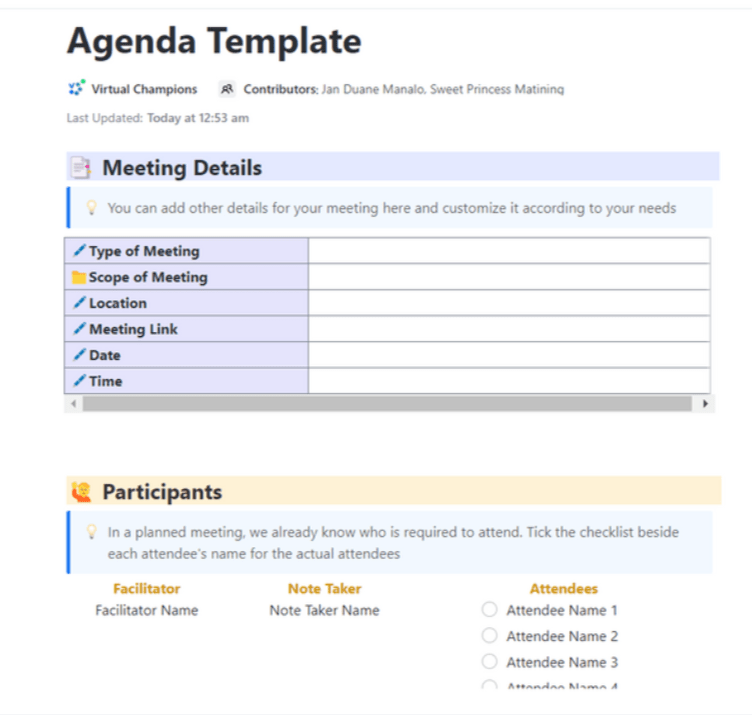
يعمل قالب جدول أعمال الاجتماعات الخاص ب ClickUp كحليف لاجتماعاتك، مما يضمن لك عقد جلسات هادفة وفعالة من خلال تحديد المواضيع والأهداف والغايات والأهداف
الخطوة 2: اجمع الفريق المناسب
يعد بناء الفريق الأمثل أمرًا بالغ الأهمية لنجاح جلسة العصف الذهني، والاجتماع هو بالضبط حيث التعاون متعدد الوظائف يجب أن يتألق. أنت بحاجة إلى أشخاص يجلبون مجموعة فريدة من الرؤى إلى الطاولة، سواء كان ذلك من المنظور الإداري أو التشغيلي، ويساعدون في التعامل مع التحديات من زوايا متعددة. 👥
إذا كنا نتحدث عن العصف الذهني، فإليك ثلاثة عوامل رئيسية يجب مراعاتها عند جمع الأعضاء من فرق متعددة الوظائف :
- الأهمية: قم بدعوة الزملاء الذين لديهم مصلحة مباشرة أو معرفة كبيرة بالموضوع المطروح. فمن المرجح أن يكونوا أكثر اهتماما بالموضوع ويساهموا بأفكار ذات مغزى
- التنوع: استهدف مزيجًا من الأشخاص من خلفيات وأقسام مختلفة. يمكن أن يؤدي التنوع إلى إطلاق رؤى ملونة وإثارة محادثات مفيدة نحو حل المشكلات
- الحجم: اجعل الفريق صغيرًا - حوالي 5-10 أشخاص. فالمجموعات الأكبر حجماً تؤدي إلى مناقشات مخففة تخنق المساهمة الفردية تقدم ClickUp عدة وجهات نظر للحصول على رؤى حول فريقك واختيار أفضل الأشخاص. على سبيل المثال، يمكنك استخدام عرض الفريق للإشراف على أعباء العمل وخبرات موظفيك واختيار المتعاونين المناسبين.
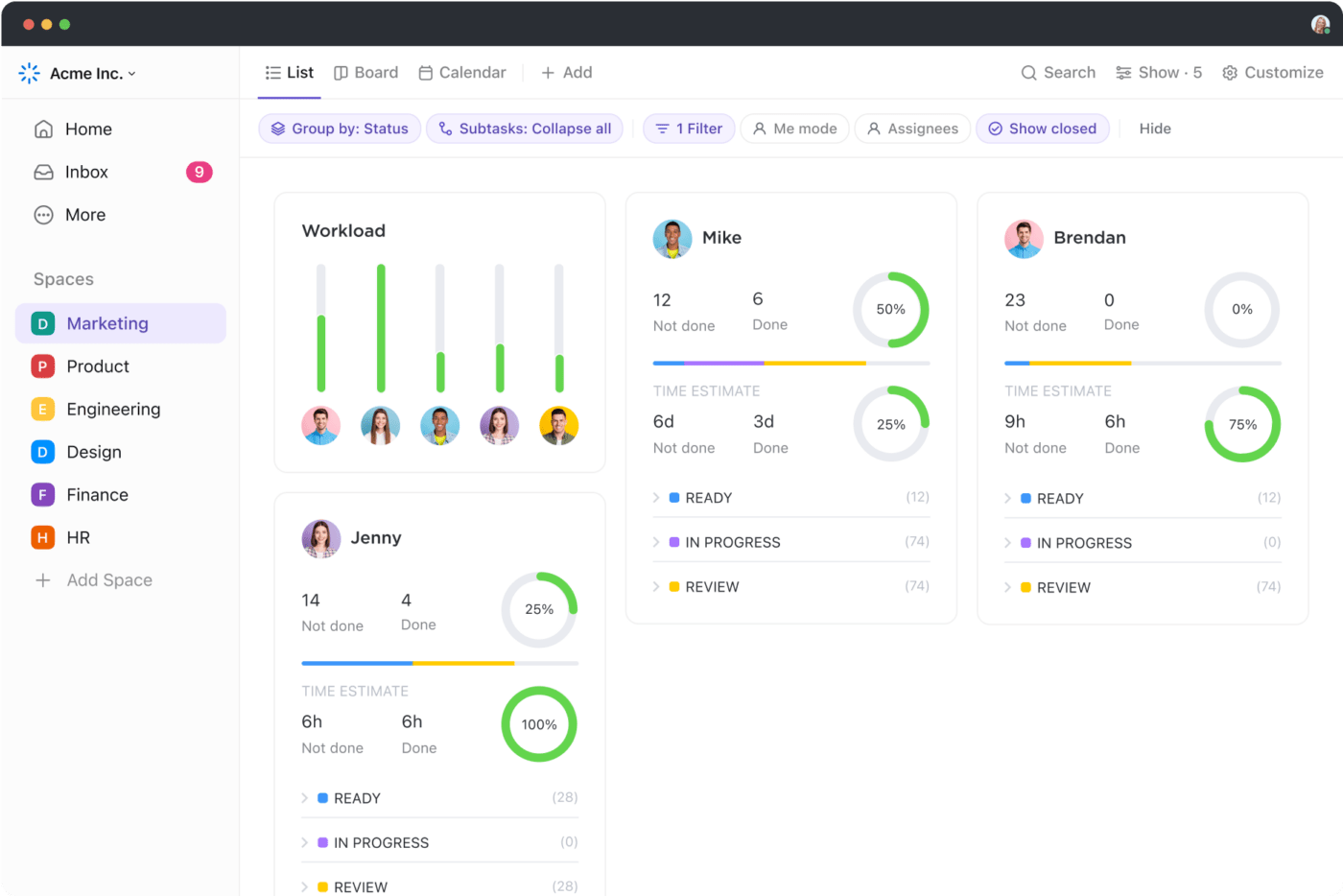
يوفر ClickUp 3.0 عرضًا مبسطًا لرؤية عبء عمل فريقك بأكمله أو فرد ما وخبرته
الخطوة 3: اختر مساحة العصف الذهني المثالية
بمجرد تجميع فريقك، قم بإعداد المسرح لجلسة عصف ذهني فعالة. من الناحية المثالية، يجب أن تُعقد الجلسة في غرفة مشرقة وجيدة التهوية مع مكاتب منظمة التي تبقي الجميع متيقظين وتهيئ الأجواء للعمل الذهني الملهم. يجب أن يكون الموقع سهل الوصول إليه ولكن هادئ نسبياً.
إذا كنت تفكر خارج حدود بيئة المكتب التقليدية، يمكنك أيضًا ترتيب هذه الجلسات في مكان خارجي أو مقهى قريب لدعوة الأفكار المتدفقة بحرية. الاجتماعات الافتراضية هي أيضًا ممتازة، شريطة أن تكون لديك مجموعة الأدوات الرقمية المناسبة لإدارة الجلسة (تمت مناقشتها في الخطوة 5).
لا يوجد مقاس واحد يناسب الجميع عندما يتعلق الأمر بأوقات إدارة الجلسات. فبعض الفرق تزدهر في جلسات العصف الذهني القصيرة والمكثفة، بينما يفضل البعض الآخر جلسات أطول وأكثر استرخاءً. أنت بحاجة إلى التجربة للعثور على أفضل ما يناسب ديناميكيات فريقك ومستويات الطاقة لديه.
لا تنسَ التفكير في التوقيت. حدد الوقت الذي يكون فيه فريقك أكثر يقظة وتقبلاً. هل هو أول شيء في الصباح أو ربما بعد الغداء؟ 🌅
يمكن أن يساعدك ClickUp هنا في تتبع الوقت الأصلي . يساعدك على الاطلاع على أكثر ساعات عمل فريقك إنتاجية و انتقاء التوقيت الأمثل لجلسات العصف الذهني. إذا كنت تدعو مستشارين من جهات خارجية إلى الاجتماع، يمكنك أيضًا استخدام الميزة من أجل تتبع الوقت المدفوع .
![]()
قم بتسجيل جلسات العصف الذهني بدقة على ClickUp وتأكد من أن فريقك يستخدم الوقت بحكمة
الخطوة 4: اختر ميسرًا مؤهلًا
يقوم الميسر المؤهل بتوجيه انحسار الطاقة الإبداعية وتدفقها، مما يحافظ على الانسجام ويمنع حدوث القبح " إلقاء اللوم " المواقف. 🤓
ومع ذلك، لا يصلح الجميع ليكونوا ميسرين. ستحتاج إلى شخص يمتلك المهارات اللازمة لتوجيه المحادثة، وإبقاء المجموعة على المسار الصحيح، وإدارة الوقت بكفاءة، وضمان سماع كل صوت. إليك بعض السمات المرغوبة:
- التواصل الفعال: يجب أن يكون الميسّر قادرًا على التعبير عن التعليمات بوضوح، والإصغاء بفعالية، وتعزيز التواصل المفتوح بين المشاركين من مختلف الأقسام
- الحياد: يجب أن يبقى محايداً، ويضمن مراعاة مساهمات الجميع، وألا يشعر أحد بالتقليل من شأنه، وألا تميل الجلسة نحو وجهات نظر متحيزة
- القدرة على التكيف: تعد القدرة على تعديل الخطط بشكل سريع أمراً بالغ الأهمية. يجب أن يكون الميسر قادرًا على تكييف اتجاه الجلسة بشكل حدسي بناءً على طاقة المجموعة وتدفقها
الخطوة 5: الاستفادة من الأدوات المناسبة أثناء الجلسة
بعد اختيار الميسر الفعال، أنت الآن جاهز لتزويد فريقك بالأدوات المناسبة لطرح أفكارهم الطموحة. لم يعد الأمر يتعلق بالأقلام أو الأوراق أو أجهزة العرض أو السبورات البيضاء المادية بعد الآن. يوفر العصر الرقمي اليوم عددًا لا يحصى من الأدوات المبتكرة الأدوات المصممة لتعزيز التعاون من خلال العصف الذهني . 🛠️
فكّر في استخدام منصة شاملة للعصف الذهني، مثل ClickUp، فهي ليست مقيدة بالمناطق الجغرافية أو المناطق الزمنية، مما يمنح فريقك حرية العصف الذهني في أي وقت وفي أي مكان. بالإضافة إلى ذلك، يمكنك الاستفادة من الألواح البيضاء اللانهائية و مستندات ClickUp لتعزيز كل جلسة!
صورة كليك أب السبورات البيضاء كملعبك الرقمي للإبداع. إنها لوحة فنية تنبض فيها الأفكار بالحياة - حيث تتفرع الحلول الطموحة، وتتحول الأشكال، وترفرف الملاحظات اللاصقة، وتنسج الموصلات نسيجًا من الابتكار.
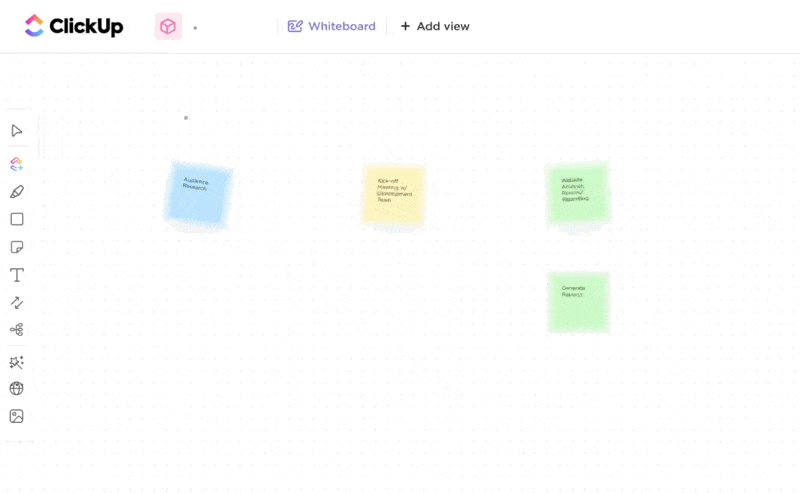
ClickUp Whiteboards هي مركزك المركزي المرئي لتحويل أفكار الفريق إلى إجراءات منسقة بشكل تعاوني
مع سبورات ClickUp Whiteboards، لن تكون جلسات العصف الذهني الخاصة بك أبدًا مبتذلة أو سطحية - إنها مناقشات تعاونية عملية في الوقت الحقيقي. هل تعجبك فكرة عشوائية؟ يمكن لجميع المشاركين القفز على الفور لإضافة نصوص وصور ورسومات وعناصر أخرى لإعطاء الحل فرصة. بهذه الطريقة، يمكنك التحقق من جدوى الأفكار بشكل أسرع من أي وقت مضى!
استخدم التعليقات والتدقيق والإشارات لمتابعة الأفكار بشكل متزامن، حتى بعد انتهاء الجلسة. إذا كنت تقوم بالعصف الذهني بمفردك، فيمكنك مشاركة هذه اللوحة الافتراضية مع أعضاء الفريق في أي وقت، مما يجعلهم مراجعين أو مشاركين في العملية. مع تكامل تكبير ClickUp ، يمكنك تقديم السبورات البيضاء إلى أي اجتماع افتراضي!
تقدم ClickUp العديد من قوالب السبورة البيضاء لتسهيل سيناريوهات العصف الذهني المختلفة. على سبيل المثال، فإن نموذج العصف الذهني للأعمال التجارية ClickUp هو تذكرتك السريعة للتفكير الجماعي المبسط في أي موضوع. ويضمن تصميمه توافق الفرق دون عناء حول مجالات مثل تحديد الأولويات ومراعاة التأثير والتكلفة والجهد - إنه أمر لا بد منه لاجتماعك الاستراتيجي القادم!
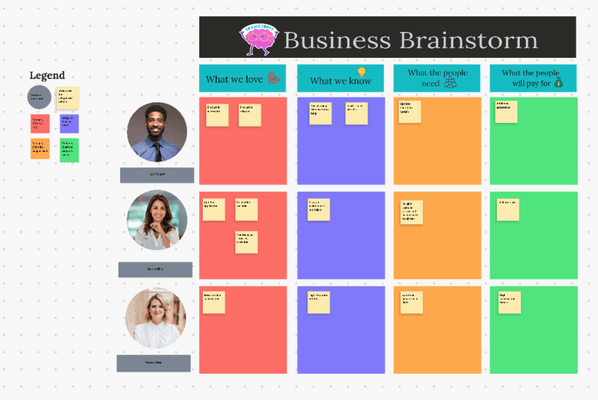
يساعد هذا القالب فرق العمل على الاصطفاف بسلاسة حول الفرص المثيرة وتحديد أولويات الأفكار بسهولة، مع مراعاة التأثير والتكلفة والجهد
مستندات ClickUp تتجاوز التقليدية، حيث توفر مساحة ديناميكية لإنشاء المحتوى وتحريره ومشاركته وتخزينه بسلاسة. سواء أكنت بحاجة إلى تخزين جداول أعمال الاجتماعات وقواعد المشاركة، أو منح المشاركين وسيلة لتدوين الملاحظات أو الحفاظ على الأفكار المتولدة منظمة وواضحة - هذه هي الأداة المناسبة لك!

التنسيق والتعاون بسهولة على المستندات جنبًا إلى جنب مع الفريق دون تداخل في ClickUp
لنفترض أنك تستعد لجلسة عصف ذهني لحملة تسويقية. باستخدام مستندات ClickUp Docs، يمكنك إنشاء صفحة تعاونية بعنوان أفكار حملة مبتكرة. وبدعوة فريقك من خبراء التسويق لديك، تقومون بشكل جماعي بتطوير أفكار لاستهداف الجمهور، والرسائل، والمرئيات، وقنوات التسليم. يتم تعيين المهام بسلاسة داخل المستند الذي يشبه المستند الرسومات إلى المصمم و المحتوى إلى مؤلف الإعلانات .
ولكن هذا ليس كل شيء - فلديك أيضًا ClickUp AI في المستندات كحليفك في العصف الذهني.

استخدام ClickUp AI لإنشاء منشور مدونة في ClickUp Docs من مطالبة بسيطة لإضافة التفاصيل والجوانب المهمة الأخرى
تأتي وظيفة الذكاء الاصطناعي المدمجة مع مطالبات خاصة بالأدوار من أجل توليد جميع أنواع الأفكار أثناء الاجتماعات .
- إذا كنت تقوم بتعديل مستند موجود، فالأمر بسيط مثل تمييز النص واختيار "AI" من شريط الأدوات. من القائمة المنسدلة للذكاء الاصطناعي، لديك الحرية في اختيار موجه أو قسم، مما يتيح لسحر الذكاء الاصطناعي توليد محتوى مخصص لاحتياجاتك
- إذا كنت تبدأ بـ مستند جديد، فإن الاحتمالات مثيرة بنفس القدر. انتقل إلىأدوات الذكاء الاصطناعي واستكشف الخيارات المتاحة
يمكن للأداة أيضًا استخراج عناصر الإجراءات من ملاحظات الاجتماع . أضف البريد الإلكتروني إلى ClickUp ، ويمكنك بسهولة إرسال ملاحظات أو أفكار قابلة للتطبيق إلى أصحاب المصلحة دون تبديل المنصات.
تقنيات العصف الذهني الجماعي التي يمكنك استخدامها لتوليد الأفكار
تخدم تقنيات العصف الذهني الجماعي غرضين أساسيين: لتحفيز المحادثات ثم تنقيح الأفكار المتولدة. إذا كنت تتعامل مع تدفق كبير من الأفكار، سيكون من الحكمة إعادة عقد الجلسة لزيادة صقل أو تضييق نطاق الاقتراحات الواعدة.
دعنا نناقش خمسة أساليب شائعة للعصف الذهني لتبسيط جهودك.
1. رسم الخرائط الذهنية
يوفر رسم الخرائط الذهنية طريقة غير خطية و نهج مرئي للعصف الذهني . يتطلب من المجموعات التركيز على سؤال أو موضوع محدد مع إقامة روابط بين الأفكار المتناثرة.
يمكنك أن تبدأ بوضع الموضوع في المركز، سواء على الورق أو السبورة البيضاء أو لوحة رقمية تعاونية مثل ClickUp. ثم تتفرع فكرة كل مشارك من المركز أو تتصل بفكرة أخرى، مما يخلق تمثيلًا مرئيًا واقعيًا مترابطًا للتفكير الجماعي.
مع تصميم سهل الاستخدام بالسحب والإفلات, انقر فوق الخرائط الذهنية يجعل صياغة الروابط وتكوين تصورات متميزة أمرًا في غاية السهولة. قم بتخصيص تجربتك من خلال الاختيار بين الخرائط الذهنية القائمة على المهام أو الخرائط الذهنية القائمة على العقدة وتنظيم الأفكار المعقدة بشكل منهجي. 🗺️
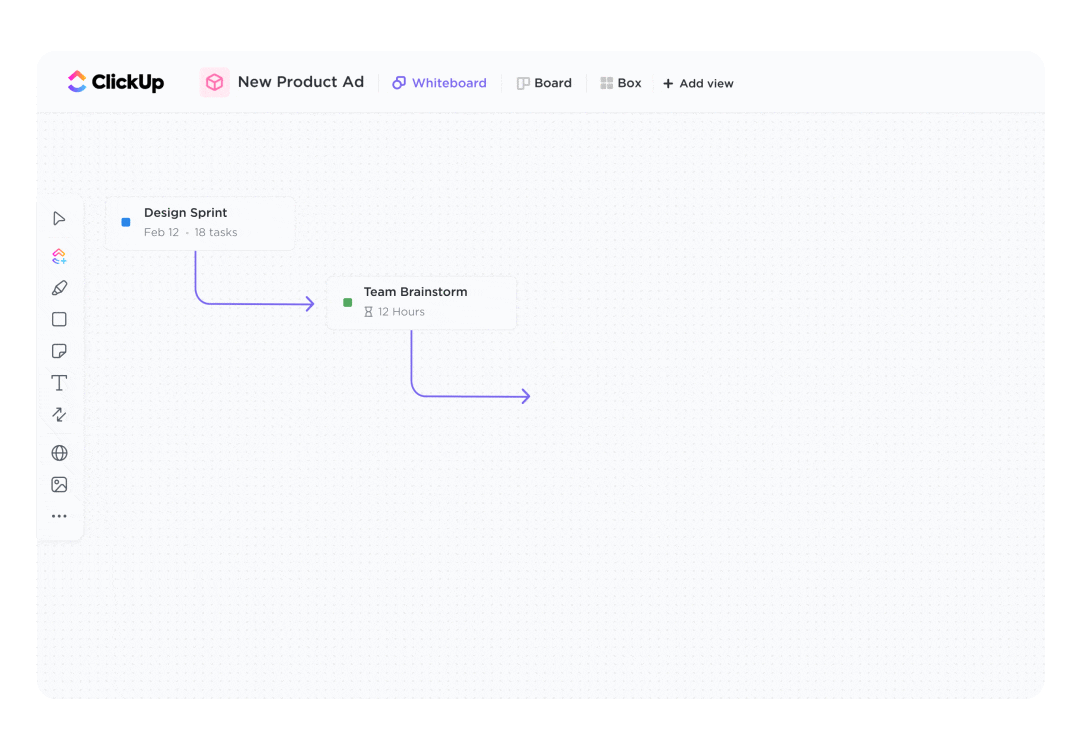
ارسم وصلات واربط العناصر معًا لإنشاء خرائط طريق أو سير عمل من أفكارك مع فريقك في ClickUp Whiteboards
يتكامل ClickUp بسلاسة مع أكثر من 1,000 أداة مثل G Suite وDropbox وGitHub، مما يزيد من قيمة خرائطك الذهنية عبر المنصات.
2. الكتابة الذهنية
في تقنية العصف الذهني غير اللفظي هذه، يقوم كل مشارك بتدوين ثلاث أفكار تتعلق بالموضوع. وبعد بضع دقائق، يطلب منهم الميسّر تمرير الأفكار إلى زميل لهم في الفريق ليقوم بالبناء عليها. تستمر هذه الدورة حتى تنتشر الأفكار حول الطاولة. لا يضمن ذلك مساهمات متوازنة فحسب، بل يكافح أيضًا تأثير التثبيت. 🤫
مكافأة: يمكنك تطبيق هذه التقنية باستخدام اللوحات البيضاء الافتراضية مع ملاحظات لاصقة لتحسين الرؤية وأوقات التشغيل. يعمل ذلك على سد الفجوة بين العصف الذهني الشخصي والراحة الرقمية. يمكنك استكشاف قالب العصف الذهني لفرقة ClickUp Squad لتنظيم جلسات الكتابة الذهنية.
3. التفكير السريع
السريع تقنية وضع الأفكار هي طريقة سريعة للتوصل إلى الكثير من الأفكار الإبداعية في فترة زمنية قصيرة. إنها عملية لفظية - تتعلق أكثر بالسماح للأفكار بالتدفق دون أن تتعثر، مع التركيز على توليد جميع أنواع الأفكار قبل التركيز على أفضلها. 💐
4. التوليد النجمي
العصف النجمي هو أسلوب عصف ذهني مصمم لـ استكشاف فكرة أو مفهوم مركزي والتساؤل عنه. فبدلاً من توليد أفكار جديدة، يركز المشاركون على طرح سلسلة من الأسئلة المفتوحة -من، و ماذا، و أين، و متى، و لماذا، و كيف - تحيط بالفكرة المركزية. والنتيجة هي رسم تخطيطي يشبه النجمة، حيث يوجد المفهوم المركزي في المركز وشبكة من الأسئلة التي تشع إلى الخارج. ⭐
إذا كنت ترغب في تجاوز الحلول السطحية، فقم بإعطاء قالب العصف الذهني ClickUp 5 Whys جرب - إنها واجهة تشبه السلالم ولكنها تعطيك نفس النتائج! أو يمكنك الاطلاع على بعض قوالب العصف الذهني هنا .

يعد هذا القالب أداة قوية لحل المشكلات لأي جلسة عصف ذهني
5. انفجار السؤال
إذا كان فريقك عالقًا في روتين العصف الذهني أو يواجه عوائق في الإبداع، فهناك حل منعش. فبدلاً من روتين العصف الذهني المعتاد، جرّب انفجار السؤال النهج. شجع الفريق على توليد العديد من الأسئلة المفتوحة والوصفية حول المشكلة المطروحة.
لا يقتصر ذلك على الابتعاد عن قالب العصف الذهني التقليدي فحسب، بل يمنع أيضًا التفكير الجماعي، ويتحدى الافتراضات، ويفتح طرقًا غير مستكشفة للحلول المحتملة. 🤯
فوائد جلسات العصف الذهني جيدة التنفيذ
ديفيد هيننغسن وزوجته ماري لين ميلر هيننغسن, أجريا دراسة كشفت أن المجموعات التي تركز على كمية الأفكار والبناء على مساهمات بعضها البعض تعزز تماسكها بشكل كبير.
تشمل بعض الفوائد البارزة الأخرى لجلسات العصف الذهني الناجحة ما يلي:
- تحسين ديناميكيات المجموعة: العصف الذهني هو في الأساس رياضة جماعية. فهو يشجع على التعاون، مما يؤكد على ديناميكيات المجموعة المثلى والإبداع. أنت قادر على تسخير الذكاء الجماعي للمجموعة، مما يؤدي إلى أفكار أكثر ثراءً وتنوعًا
- الاستراحة من الرتابة: تميل واجبات العمل اليومية إلى التأثير على العاملين بمرور الوقت. تعد جلسات العصف الذهني بمثابة نسمة هواء منعشة في مساحة العمل لأنها تتيح للمشاركين استكشاف مهاراتهم والتوصل إلى أفكار مبتكرة
- فرصة للتعلم: تسمح هذه الجلسات باستكشاف مفاهيم وأفكار جديدة، كما أنها تمهد الطريق لتبادل المهارات والمسائل المعرفية. وهذا يمهد الطريق للتطوير الشخصي والمهني على حد سواء
قم بتجميل جلسات العصف الذهني الخاصة بك مع ClickUp
متسلحًا بخطوات وتقنيات العصف الذهني الفعّالة والقدرات الديناميكية التي يوفرها ClickUp، أصبح لديك الآن جميع الأدوات اللازمة لدفع جلساتك الجماعية. اشترك في ClickUp اليوم واستكشف ما يمكنك القيام به - ليس فقط للاجتماعات ولكن لمشاريعك بشكل عام! 🌌

